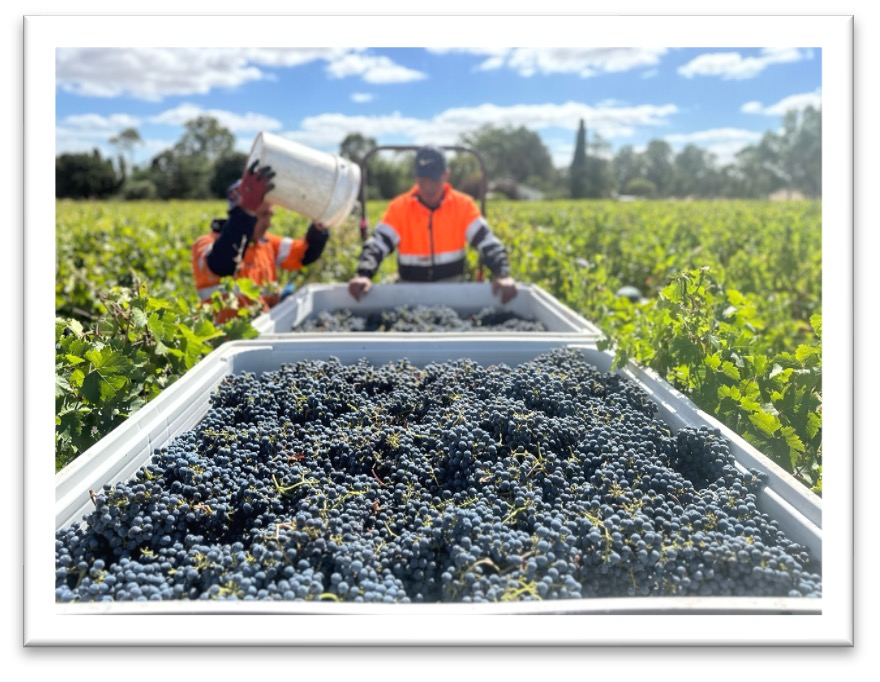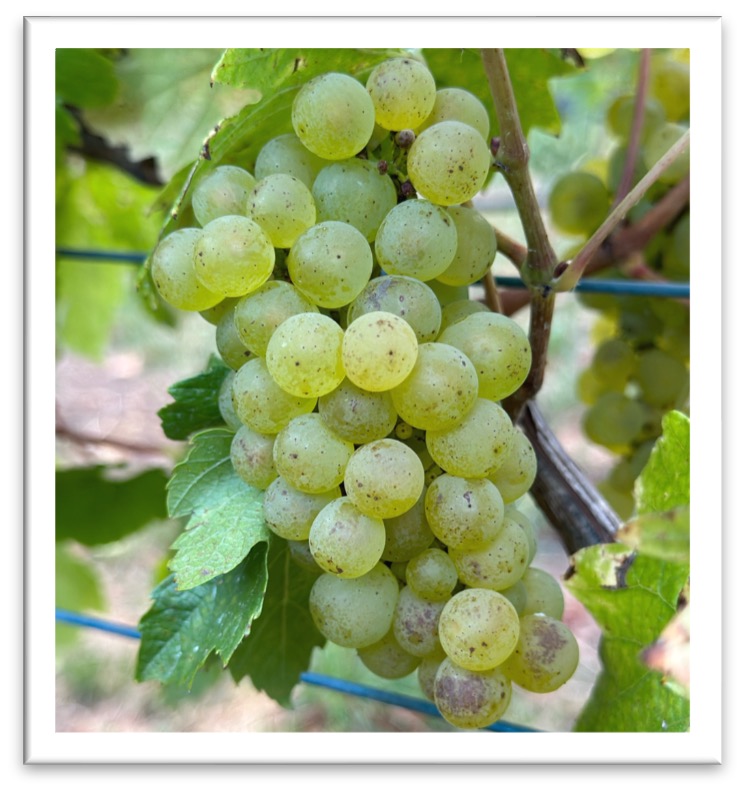TERRE à TERRE
Crayères Vineyard, Wrattonbully
The 2024 vintage started very cool and wet in our Crayères Vineyard until the end of January, with warmer temperatures and drier conditions in February and March leading up to harvest. The warmer summer conditions, combined with our efforts to control yields and manage an open canopy, allowed us to ripen all varieties, Sauvignon Blanc, Cabernet Sauvignon, Shiraz, and Cabernet Franc, to perfection.

DAOSA
Piccadilly Valley
The 2024 vintage started cool and wet, which gave us above to average rainfall until the end of January. This was followed by a very warm and dry month of February accelerating ripening. The minute crops of Pinot Noir, Pinot Meunier and Chardonnay destined for sparkling wine, were all harvested earlier than usual, with very good acidity and very expressive flavours. 2024 will be an exceptional year for our sparkling wines.
Overall
The 2024 vintage began as a challenging one for viticulturists in the Adelaide Hills and Limestone Coast. However, the warmer and drier months of February and March allowed us to ripen the fruit to perfection both in our Piccadilly and Crayères Vineyards; enabling us to produce some exceptional wines in 2024.
—
TERRE à TERRE
Crayères Vineyard, Wrattonbully (Limestone Coast)
Our Sauvignon Blanc was hand-picked over the 6th and 7th of March; one week earlier than 2023, with good acidity and ripe, spicy flavours. Through yield control at the start of season (shoot thinning), and before véraison (bunch thinning), we efficiently managed canopy and bunch exposure, allowing for perfect ripening during the warmer month of February. One third of the fruit was whole bunch pressed and is now fermenting in oak. Two thirds of the fruit was crushed and destemmed before pressing and is fermenting in tank and old oak. We left a few rows for late harvest, which were picked on the 4th of April with high sugars and a small level of Botrytis, exhibiting superb flavours.
For the second time, our three red varieties were harvested during the same week in the Crayères Vineyard.
Our Shiraz was hand-picked on the 19th of March; two weeks earlier than in 2022 and 4 weeks earlier than in 2023, with good yields and very ripe flavours. It is now finishing malolactic fermentation in tank. It will be an excellent vintage for our Shiraz, with very expressive fruit flavours and great tannin structure.
Our Cabernet Franc was hand-picked on the 19th and 20th of March; one month earlier than 2023, with good yields. The quality is yet again truly exceptional for our Cabernet Franc, with striking red berry flavours and great tannin profile. The Cabernet Franc is now finishing malolactic fermentation in tank and is very promising.Our Cabernet Sauvignon was hand-picked on the 20th and 21st of March; almost 4 weeks before 2022 and 2023 and was the earliest harvest of our Cabernet Sauvignon in the last 12 years. Due to our stringent pre-véraison bunch thinning, the yields were lower than that of our Shiraz and Cabernet Franc. The warmer months of February and March, combined with the direct effect of close spacing on bunch exposure, had our fruit ripening to perfection. Cassis and liquorice characters were evident at harvest, like every year. The wine is now starting malolactic fermentation in stainless steel tank and will be one of our best Cabernet Sauvignon to date.
Comparison of previous vintages Crayères Vineyard, Wrattonbully
Growing season (October to April) heat summation (DD) base 10°C
| YEAR | 1980- 2024 AVE | 2016 – 2017 | 2017 – 2018 | 2018 – 2019 | 2019 – 2020 | 2020 – 2021 | 2021 – 2022 | 2022 – 2023 | 2023 – 2024 |
| Wrattonbully (Joeville), CliMate data | 1489 | 1514 (+1.7%) | 1795 (+20.5%) | 1630 (+9.5%) | 1481 (-0.6%) | 1469 (-1.3%) | 1566 (+5.2%) | 1409 (-5.4%) | 1504 (+0.9%) |
% of average rainfall during growing season (October to April)
| Year | 2016 -2017 | 2017 -2018 | 2018 -2019 | 2019 -2020 | 2020 -2021 | 2021 -2022 | 2022 -2023 | 2023 -2024 |
| Wrattonbully (Joeville), CliMate data | 152% | 87% | 73% | 80% | 87% | 67% | 147% | 97% |
Pre-Véraison (October – January) heat summation (DD) base 10°C and rainfall (mm)
| Year | 1980-2024 avg | 2016 -2017 | 2017 -2018 | 2018 -2019 | 2019 -2020 | 2020 -2021 | 2021 -2022 | 2022 -2023 | 2023 -2024 |
| Wrattonbully (Joeville), CliMate data | 830DD | 792DD | 1028DD | 956DD | 862DD | 866DD | 871DD | 805DD | 839DD |
| 152mm | 230mm | 158mm | 129mm | 90mm | 140mm | 91mm | 209mm | 207mm |
Post-Véraison (February & March) heat summation (DD) base 10°C and rainfall (mm)
| Year | 1980- 2024 avg | 2016 -2017 | 2017 -2018 | 2018 -2019 | 2019 -2020 | 2020 -2021 | 2021 -2022 | 2022 -2023 | 2023 -2024 |
| Wrattonbully (Joeville), CliMate data | 521DD | 580DD | 568DD | 528DD | 494DD | 474DD | 519DD | 463DD | 568DD |
| 46mm | 49mm | 7mm | 27mm | 48mm | 43mm | 54mm | 63mm | 0mm |
Heat summation was average for our Crayères Vineyard, with warmer temperatures post-véraison versus pre-véraison, when compared with average. Rainfall was also on average for the growing season; well above pre-véraison and well below post-véraison. Overall, the vintage was temperate and dry, with some heat after véraison, favouring very efficient ripening of the red varieties.
Crayères Vineyard, Wrattonbully
Harvest date per variety for the last 12 years
| Sauvignon Blanc | Shiraz | Cabernet Franc | Cabernet Sauvignon | |
| 2013 | 26 February | 7 March | 20 March | 27 March |
| 2014 | 13 March | 3 April | 8 April | 8 April |
| 2015 | 19 February | 17 March | 25 March | 29 March |
| 2016 | 26 February | 16 March | 22 March | 23 March |
| 2017 | 23 March | 10 April | 11 April | 19 April |
| 2018 | 27 February | 19 March | 20 March | 26 March |
| 2019 | 5 March | 19 March | 26 March | 4 April |
| 2020 | 5 March | 30 March | 8 April | 6 April |
| 2021 | 24 February | 25 March | 31 March / 7 April | 8 April |
| 2022 | 8 March | 1 April | 6 April | 11 April |
| 2023 | 16 March | 12 April | 13 April | 14 April |
| 2024 | 6 March | 19 March | 20 March | 21 March |
—
DAOSA – PICCADILLY VALLEY (ADELAIDE HILLS)
Our Piccadilly Valley vineyards produced minute yields of exceptional sparkling base Pinot Noir, Pinot Meunier and Chardonnay fruit. We also harvested some very good fruit from various Adelaide Hills vineyards for our table Rosé.
DAOSA Blanc de Blancs
Bizot Vineyard and Summertown Vineyard
Chardonnay: clones 76, 95, 96 and 277 from the Bizot Vineyard, and OF clone from Summertown Vineyard, used for our DAOSA Blanc de Blancs base, was picked by hand on the 2nd and 3rd of March. Yields were extremely low at less than 2.5t/ha, which allowed us to perfectly ripen our Chardonnay grapes for sparkling. The quality is exceptional, as can be expected from a cool year in the Piccadilly Valley. However, the warmer and drier month of February ripened the flavours and aromatics further, with stone fruit and grapefruit characters combined with high acid and great ‘minerality’. The whole bunch pressed juice has finished fermenting in demi-muids and barrels, and is going through malolactic fermentation.
DAOSA Natural Réserve 9th Release
Piccadilly Valley Vineyards
Extremely low yields of Pinot Noir and Pinot Meunier from our Piccadilly Valley vineyards were hand harvested on the 24th and 25th of February, one full month earlier than in 2023. The fruit is strikingly good for sparkling wine, with good acidity, ripe fruit flavours and perfect sugar levels. Very low yields of Chardonnay from our Piccadilly Valley vineyards were hand harvested on the 2nd and 3rd of March, one month earlier than in 2023, at perfect ripeness, and will make a great blending component with the Pinot Noir and Pinot Meunier for the DAOSA Natural Réserve 9th release.
TERRE à TERRE Piccadilly Rosé
Summertown Vineyards and Mount Barker Vineyard
On the 13th of March, we hand-picked Sangiovese from a new vineyard in the outer Adelaide Hills. On the 22nd of March the Merlot, Trousseau Noir, Mondeuse and Cabernet Franc were also hand-picked from the Summertown vineyards and some Saperavi and Shiraz, from a small vineyard in Norton Summit, north of the Piccadilly Valley, for the Piccadilly Rosé.
Comparison of the previous five vintages in the Piccadilly Valley
Growing season (October to April) heat summation base 10°C days
| YEAR | 1980- 2024 AVE | 2016 – 2017 | 2017 – 2018 | 2018 – 2019 | 2019 – 2020 | 2020 – 2021 | 2021 – 2022 | 2022 – 2023 | 2023 – 2024 |
| Mt Lofty, CliMate data | 1168 | 1328 (+4.4% | 1513 (29.7%) | 1462 (+25.4%) | 1181 (+1.3%) | 1232 (+5.7%) | 1183 (+1.4%) | 1094 (-6.2%) | 1224 (+4.8%) |
% of average rainfall during growing season
| Year | 2016 -2017 | 2017 -2018 | 2018 -2019 | 2019 -2020 | 2020 -2021 | 2021 -2022 | 2022 -2023 | 2023 -2024 |
| Mount Lofty, CliMate data | 169% | 86% | 79% | 112% | 92% | 91% | 107% | 110% |
Pre-Véraison (October-April) heat summation DD base 10°C and rainfall (mm)
| Year | Avg 1980 -2024 | 2016 -2017 | 2017 -2018 | 2018 -2019 | 2019 -2020 | 2020 -2021 | 2021 -2022 | 2022 -2023 | 2022 -2023 |
| Mount Lofty, CliMate data | 640DD | 613DD | 844DD | 830DD | 742DD | 458DD | 612DD | 605DD | 608DD |
| 204mm | 430mm | 190mm | 209mm | 273mm | 214mm | 251mm | 281mm | 330mm |
Post-Véraison (February & March) heat summation DD base 10°C and rainfall (mm)
| Year | Avg 1980 -2024 | 2016 -2017 | 2017 -2018 | 2018 -2019 | 2019 -2020 | 2020 -2021 | 2021 -2022 | 2022 -2023 | 2022 -2023 |
| Mount Lofty, CliMate data | 424DD | 484DD | 471DD | 482DD | 361DD | 385DD | 438DD | 394DD | 562DD |
| 67mm | 83mm | 28mm | 49mm | 76mm | 63mm | 35mm | 95mm | 8mm |
The 2024 vintage in the Piccadilly Valley was close to the long-term average. However, the growing season was particularly cool and wet up to véraison, as compared to average, and much warmer and drier than average post-véraison, which accelerated ripening. The 2024 vintage will produce some excellent sparkling wines with freshness and fruit ripeness; however, the volumes will be very small.



